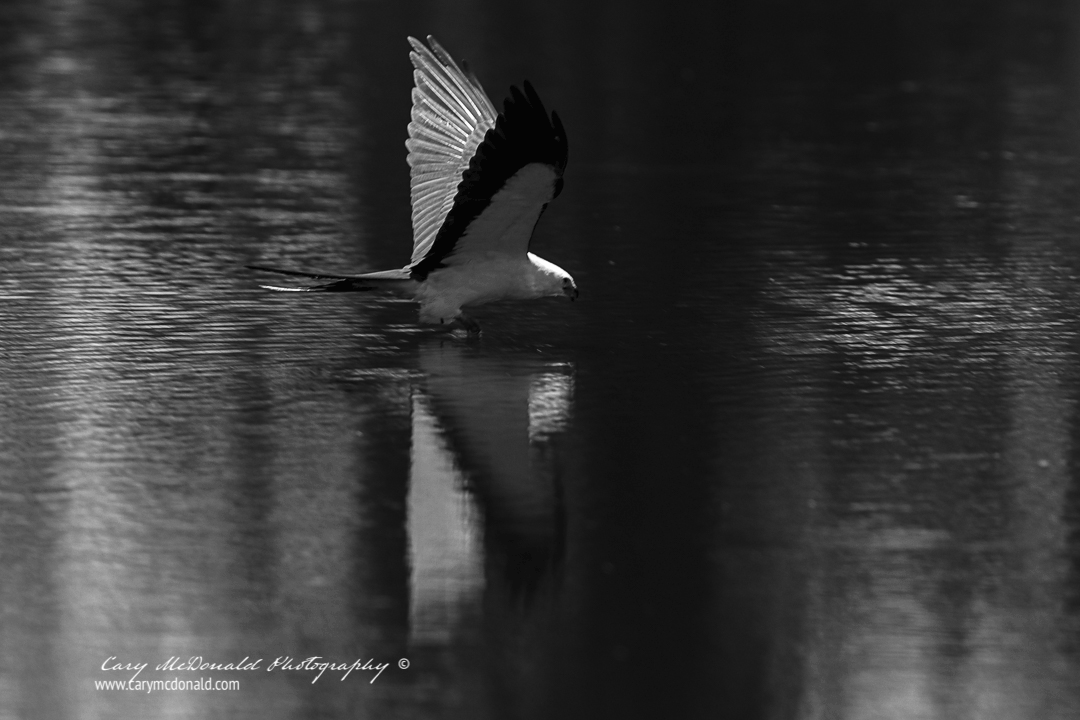
Taking sharp photos of moving subjects takes lots of practice. Practice and time getting used to the subjects movement. With all birds they follow patterns. Learning these general patterns help anticipate their movement and photograph them in unique situations. Birds often poop before taking flight if they have been perched for a while, for example. Anyone that has watched a bird of prey eat on a limb has noticed this. Some groups of birds start lifting their wings and point their heads down before the group decides to all fly away.

Kites circle before drinking in ponds near their food supply. They come in from various directions and depending on the lack of wind, it can be unpredictable which direction they will be drinking from. If you sit at the same pond long enough, and you have enough birds drinking consistently through the day, you will notice they tend to be comfortable drinking from the same directions or pick out common lines where they drink. When you have 5 or 6 birds drinking at the same time over a small pond with various trees and vegetation around the pond, some paths must be easier for the birds and lend them selves to concurrent flyers drinking.

Taking photos then comes down to the distance to your subjects lines, camera and skills with the camera. Most cameras can take 3-12 frames a second and have complex auto focus modes. For example AI Servo AF (Canon) and Continuous-Servo AF (Nikon) are the two most common names for the auto focus and camera systems. (I’m currently a Canon shooter). My 5DM4 takes 7 frames a second and what I was using mostly shooting the kites. My 90D shoots more frames a second, but the focus system is not quite as good as the 5DM4. The longer the lens you are using, the harder it is to keep the subject in the very center of the lens as you are shooting. So if you are new to shooting moving subjects, start with a 200mm lens, and work your way up to larger lenses as you are able to tract the subject better.

After working hard on getting used to getting the birds in flight in focus with a longer lens, then it gets really hard. As the birds change angles it gets even more difficult. As a bird goes across you field of view in a straight line, then it changes to across your field of view in a curve, dive or dip. When a bird fly across your field of view, you only have to worry about speed. When a bird comes towards you, you have to worry about velocity. As the distance between you and your subject is reduced, the apparent velocity will increase. Closer objects appear faster and are harder to focus. The speed of your lens moving slows down, and it appears you are tracking a slower subject, but really it is going the same speed but directly towards you.

So a subject coming directly towards you like a kite drinking, is getting closer to you relatively faster than going across your view. A baseball being pitched looks a lot faster, when it is flying towards your head, or anything for that matter. LOL. Same with a bird of prey coming straight towards you. It appears to be moving faster, but when this happens, you have to move your camera less to keep it in the center of your lens or in the center of you censor. Your camera with a large lens like 600-800mm also will struggle to keep up focusing on the subject that may give you a smaller profile head on.

Or to put it another way, swallow-tail kites are traveling about 30-40 feet a second, hopefully straight towards you when grabbing a drink or washing their feet, at unknown and completely random intervals which may only occur a few times over six hours in a day. They are only close to the water for just over a second in most cases. To get the shot you want, you have to anticipate when it is going to occur and track the bird. The chance of getting a sharp image decreases the closer it gets to you, because your Depth of Focus (DOF) decreases every foot closer they move. At 60 feet, you can get about 1.5 feet in focus from front to back at 800mm and at 20 feet it is only about 2 inches in focus. Getting good usable images means being prepared, and spending many hot days out in the sun.
But being able to spend time watching these amazing creatures perform amazing acrobatic feats of flight so gracefully while eating and drinking is completely amazing.

This was also my first attempt at making GIFs in Photoshop. It took a little time to get used to making them, but I enjoy watching them.
